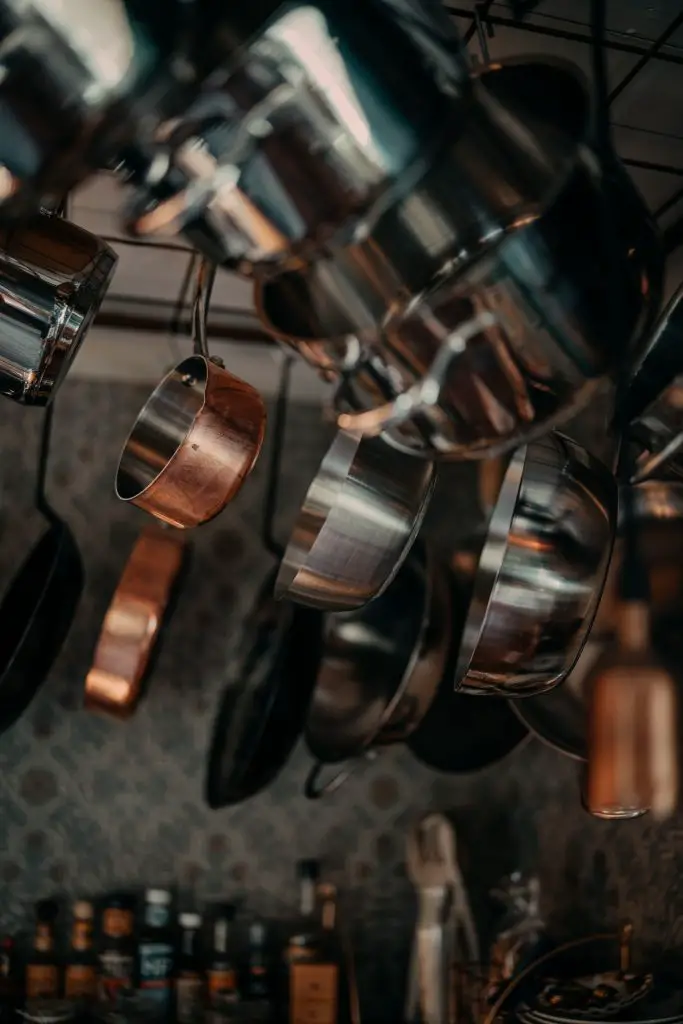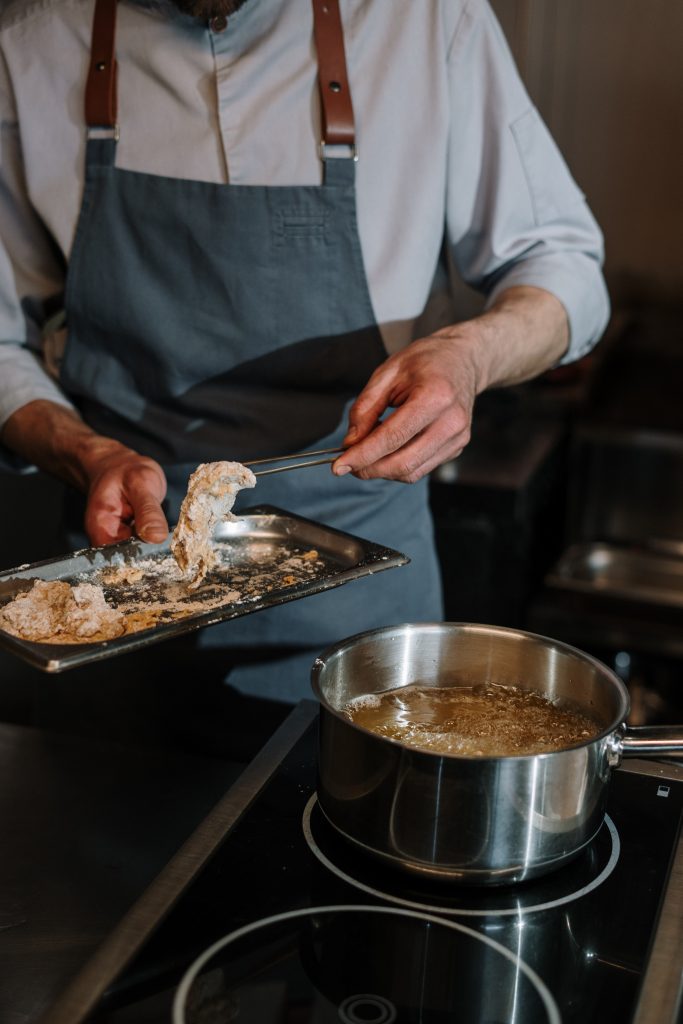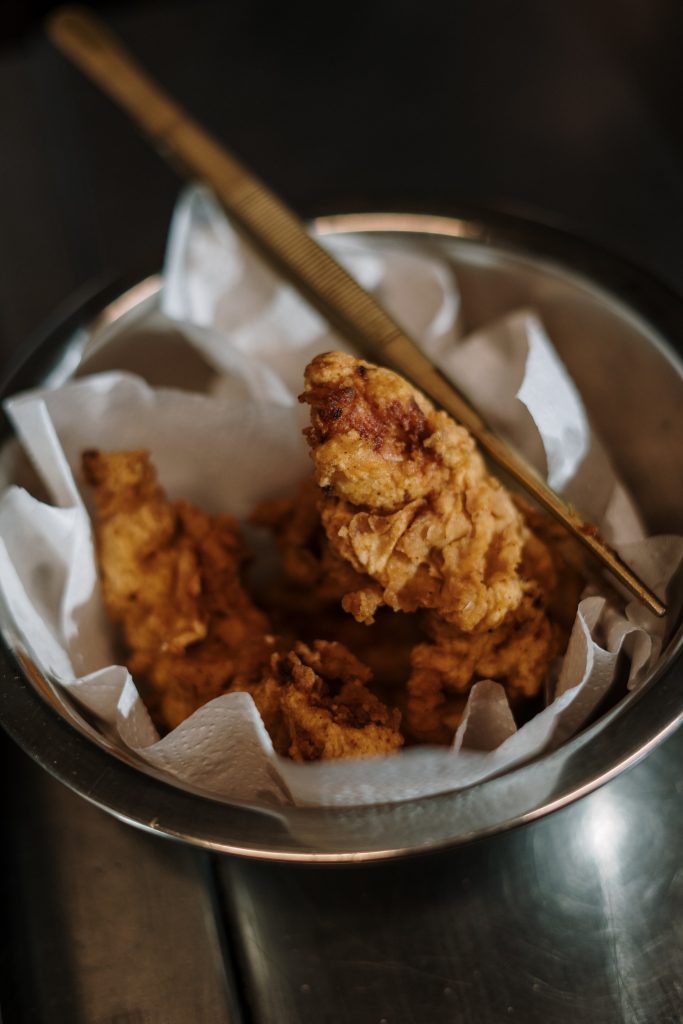As an Amazon Associate we earn from qualifying purchases.
All you need is the right pot, oil, and utensils to deep fry without a deep fryer. But learning the proper deep-frying technique is essential if you don’t want to burn your food – or worse – yourself.
This guide will teach you how to deep fry without a deep fryer.
Quick Navigation
How to Deep Fry Without a Deep Fryer
Here’s a step-by-step breakdown:
Step #1: Get a Pot
The idea behind deep frying is that you want the food to be submerged in oil completely. Find a vessel that’s deep enough to accommodate the food.
Don’t forget that there will be oil in the pot – account for the space the oil will occupy when picking a vessel.
If you pick a smaller, shallower vessel, the food won’t fry correctly. Furthermore, smaller vessels pose a higher risk of oil splatters. If that is your only option, make sure to pick up an electric skillet designed for frying.
Using a dutch oven is the best way to go. But if you don’t have an oven to cook, use any vessel that’s big enough. Avoid non-stick vessels since managing the oil’s temperature with them is difficult.

Step #2: Get Some Oil
But not just any oil – the oil you use to deep fry must have a high smoke point, which is the temperature at which the oil starts to burn and smoke.
Cooks most often prefer using vegetable, canola, or peanut oil, since they have the highest smoke points. These oils also have a neutral flavor, which ensures that the food’s flavors remain unaltered.
If you want to fry your food in the healthiest alternative, you can use extra virgin olive oil.

—
Warning
While rich in anti-oxidants, extra virgin olive oil has a slightly lower smoke point (374°F/190°C) than other oils. If your food needs to be fried at temperatures higher than its smoke point, don’t use olive oil.
—
Step #3: Fill the Pot With Oil
Consider this:
According to the U.S. Consumer Product Safety Commission, burns are the most common injury resulting in ER visits when using ovens, ranges, and cookware.
Knowing how much oil to use is critical for your safety.
Never fill the pot up with oil all the way to the top. If you do this, when you lower the food into the pot, the oil will spill out and splatter, burning you in the process.
Fill the pot with oil a little higher than the halfway point of the pot. It should be enough to submerge the food while giving you the clearance you need from the top of the pot for safety.
Step #4: Heat the Oil
Different fried recipes need to be done at different temperatures, and getting the oil to the required temperature before dipping food in is vital to ensure it tastes great.
If the oil isn’t hot enough for the food, the food will get greasy and limp. On the other hand, if the oil is too hot, it will char the food.
You can use a frying or candy thermometer to monitor the oil’s temperature.
You must bear in mind that when you add food to the oil to fry, the oil temperature will drop. You must monitor and manage the heat even after you dip the food into the oil.
Step #5: Grab a Utensil
Never lower food into the oil with your bare hands. Use either a slotted spoon or a spider to dip food in and scoop it out of the hot oil. If you don’t have a slotted spoon, a sieve will do the trick.
If you’re frying chicken or other relatively big items, you can use tongs or chopsticks to dip and grab the pieces.
Step #6: Ready a Bowl/Plate
Before you get to frying, have a plate or a bowl lined with paper towels ready to put the fried food away. The paper towels will absorb the excess oil and fat.
When the bowl or plate is full, serve the food right away while it is nice and crispy. If you cannot serve the fried food right away, make sure you crisp it up in the oven before serving it later.
Step #7: Start Frying
To deep fry food correctly:
- Ensure that the oil is hot enough. If your recipe doesn’t indicate any temperature, heat the oil up to 350°F.
- Lower a batch of food into the oil gently. Make sure you only dip a little food since dipping too much food will bring the temperature of the oil down drastically.
- If the temperature is right and you’ve lowered the right amount of food, the oil around the food will start to bubble.
- Use your utensil to nudge the food away from each other, so every piece cooks evenly.
- When you see the food has turned an appetizing golden brown, scoop it out of the pot and place it in the plate/bowl.
- Repeat these steps with the next batches until you’ve fried all the food.

Step #8: Season and Enjoy
Season the food with salt when freshly out the pot to give it a zestful smack of flavor.
Enjoy the deep-fried food with your favorite chilled beverage.
Frequently Asked Questions
Can you deep fry in a normal pan?
Most foods need between four and six cups of oil for deep frying. If you have a pan that can hold that much oil without spilling out when you dip food in, you can use it to deep fry food.
Can you deep fry on an electric stove?
Yes, you can, but it can be tricky and dangerous. You will need a thermometer to monitor and manage the temperature.
Use the “High” setting on the stove to heat the oil up to the required temperature. Then, turn on another burner at the “Med” setting and move the pot between the two burners as required to manage the temperature.
Can I air fry instead of deep fry?
No other frying technique can match the consistency of the food that deep-frying provides. Furthermore, air frying can dry out some foods.
Conclusion
Whether you want to indulge in some chicken tenders, finish some sous vide food, or try an exotic recipe you saw on the internet (deep-fried Oreos, maybe?), you can use the steps outlined above to deep fry food without a deep fat fryer.
